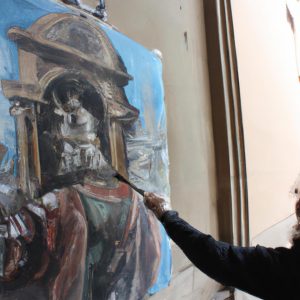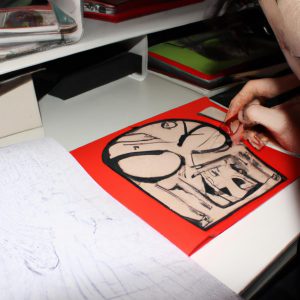Art Conservation in the Context of Arts and Comics: A Comprehensive Overview

Art conservation plays a crucial role in preserving and safeguarding the rich cultural heritage of arts and comics. By employing various scientific techniques, art conservators aim to analyze, document, prevent deterioration, and restore artworks to their original condition. This comprehensive overview delves into the multifaceted field of art conservation within the context of arts and comics, examining its historical background, key principles, methods employed, challenges faced by conservators, and the significance of conservation efforts.
Consider a hypothetical case study where an ancient comic book from the 1930s is discovered in a dilapidated state. The pages are yellowed with age, exhibiting signs of discoloration and brittleness. As an invaluable artifact representing early graphic storytelling, this comic book holds immense historical value for collectors and researchers alike. However, without proper intervention through art conservation practices, it risks being lost forever due to irreversible damage caused by environmental factors or poor handling over time.
To address such pressing issues surrounding art preservation in the realm of arts and comics, this article explores diverse aspects related to conservation ethics, documentation strategies used during examination processes, preventive measures adopted to mitigate further deterioration risks, as well as restoration techniques implemented to revive damaged artwork. Understanding these fundamental concepts will foster a deeper appreciation for the importance of art conservation in preserving and safeguarding our cultural heritage, ensuring that future generations can continue to enjoy and study these valuable artifacts.
The Importance of Art Conservation
Art conservation plays a crucial role in preserving and safeguarding artistic heritage. Through the application of scientific methods and techniques, art conservators help extend the lifespan of artworks, ensuring their continued enjoyment for future generations. To illustrate this significance, let us consider the case study of Leonardo da Vinci’s iconic painting, “The Last Supper.” This masterpiece has faced numerous challenges over time due to its location within a Dominican monastery that was bombed during World War II.
Firstly, one must recognize the emotional impact that artwork holds on individuals and communities alike. Artworks often serve as visual representations of cultural identity and historical memory. They have the power to evoke deep emotions and provoke contemplation. Imagine visiting an art museum where you can stand before Vincent van Gogh’s vibrant “Starry Night” or Michelangelo’s breathtaking “David.” These encounters with exceptional works of art move us, inspire creativity, and foster connections across time and space.
To further emphasize the importance of art conservation, consider these key points:
- Preservation: Conservation efforts ensure that valuable cultural artifacts are protected from deterioration caused by environmental factors such as light exposure, temperature fluctuations, humidity levels, pests, and pollutants.
- Restoration: When damage occurs to an artwork, skilled conservators employ meticulous restoration techniques to repair it while maintaining respect for its original form.
- Research: Conservation practices involve extensive research into materials used by artists throughout history. By understanding these materials better, conservators can develop effective preservation strategies.
- Education: Art conservation promotes public awareness about our collective responsibility towards preserving artistic treasures. It encourages education initiatives that teach proper handling techniques and care for both professionals and enthusiasts.
| Preserving Cultural Heritage | |
|---|---|
| 1 | Ensures continuity |
| 2 | Fosters appreciation |
| 3 | Protects historical memory |
| 4 | Encourages cultural exchange |
In conclusion, art conservation is vital for the longevity and appreciation of artistic heritage. By preserving and restoring artworks, conservators ensure that these cultural treasures continue to inspire and educate future generations. In the subsequent section, we will delve into the intricacies of defining art conservation and its underlying principles.
Now let us transition our focus towards Defining Art Conservation as a crucial step in understanding this field comprehensively.
Defining Art Conservation
Following the exploration of the importance of art conservation, we now delve into understanding the various methods and techniques used in this intricate process. To illustrate these practices, let us consider a hypothetical case study involving a delicate comic strip from the 1950s that has suffered damage due to exposure to light and improper storage conditions.
When approaching the restoration of such a piece, art conservators employ a range of methods tailored to address specific issues. Firstly, they carefully assess the artwork’s condition, noting any visible signs of damage or deterioration. In our case study, observations may include faded ink lines and paper discoloration caused by prolonged sunlight exposure. This initial examination allows conservators to establish an informed plan for treatment.
To rectify light-induced fading, one common technique employed is inpainting. Conservators meticulously apply paints with pigments matching those originally used in the artwork to restore areas where colors have diminished over time. By using reversible materials, they ensure that future restorations can be carried out without compromising the integrity of the original piece.
In addition to inpainting, another critical method utilized in art conservation is deacidification. Over time, paper-based artworks can become acidic due to environmental factors or poor quality materials used during production. Deacidifying agents are applied to neutralize acid residues within the paper fibers, thereby slowing down further degradation processes and preserving the artwork’s structural stability.
As we explore these methodologies further, it becomes evident how crucial art conservation is in safeguarding cultural heritage for future generations. It not only involves technical expertise but also requires an understanding of artistic intent and historical context. The table below provides a glimpse into some key aspects encompassed within art conservation:
| Key Aspects | Description |
|---|---|
| Preventive Measures | Implementing strategies to prevent future damage |
| Documentation | Recording detailed information about artworks |
| Environmental Control | Maintaining optimal conditions for preservation |
| Ethical Considerations | Adhering to professional standards and ethics |
By incorporating these aspects into the conservation process, professionals ensure comprehensive care that encompasses all dimensions of an artwork’s life cycle.
Moving forward, we will now delve into the methods and techniques used in art conservation, shedding light on how conservators employ their expertise to restore and preserve artworks.
Methods and Techniques Used in Art Conservation
Building on the foundation of understanding art conservation, this section delves into the methods and techniques employed by art conservators to preserve and restore artworks. By employing a variety of approaches tailored to each individual artwork’s needs, these professionals strive to safeguard artistic heritage for future generations.
Methods and Techniques:
Art conservation encompasses an array of specialized methods and techniques that aim to repair damage, prevent deterioration, and enhance the longevity of artworks. One example showcasing the breadth of these practices is the treatment of a delicate watercolor painting with significant discoloration caused by exposure to light over time. In such cases, conservators employ meticulous processes like surface cleaning, deacidification, color retouching, and UV filtering glazing. These interventions ensure both aesthetic restoration and long-term preservation.
To further illustrate the multifaceted nature of art conservation techniques, consider the following bullet points:
- Surface Consolidation: This method involves stabilizing loose or flaking paint layers using adhesives specifically formulated for art preservation.
- Varnishing: Applying a protective layer of varnish not only enhances an artwork’s appearance but also shields it from environmental factors such as dust accumulation.
- Paper Repair: Conservators utilize various paper repair techniques like mending tears with archival materials or reinforcing weakened areas with Japanese tissue paper.
- Structural Reinforcement: For sculptures or three-dimensional works experiencing structural instability, conservators may use materials like resins or adhesives to strengthen weak points.
The diverse range of methods used in art conservation extends beyond what can be fully explored within this brief overview. However, it is crucial to acknowledge that each technique utilized adheres to professional ethical guidelines and undergoes rigorous testing before implementation.
As we transition into exploring the challenges faced by art conservators in their pursuit of protecting our cultural heritage (as discussed in the subsequent section), it becomes evident that these talented individuals must navigate a complex landscape. The nuances of art conservation extend beyond technical expertise, encompassing ethical considerations, and the need to strike a delicate balance between preservation and restoration.
Challenges Faced by Art Conservators
Building upon the understanding of art conservation, this section delves into the various methods and techniques employed by art conservators to preserve and restore artworks. By exploring these practices, we can gain insight into the intricate processes involved in maintaining artistic masterpieces for future generations.
One notable example illustrating the complexity of art conservation is the restoration of a deteriorated oil painting from the 17th century. The conservators carefully examined the artwork’s condition, identifying areas where paint had cracked or flaked off. To stabilize these fragile sections, they used a technique called “consolidation,” which involved applying adhesive solutions beneath loose flakes while ensuring minimal visual impact on the original composition. This process highlights how conservators strive to strike a delicate balance between preserving an artwork’s integrity and addressing its physical decay.
To further illustrate the range of methods used in art conservation, consider the following bullet points:
- Surface cleaning: Conservators employ specialized tools and solvents to remove accumulated dirt, grime, or discolored varnishes that may have altered an artwork’s appearance.
- Inpainting: When faced with losses or damages within an image, conservators skillfully reintegrate missing elements using compatible materials and carefully selected pigments to ensure seamless integration.
- Structural reinforcement: For sculptures or three-dimensional objects prone to structural issues, conservators utilize innovative techniques such as resin casting or metal reinforcements to enhance stability without compromising their aesthetic qualities.
- Environmental control: Taking preventive measures plays a crucial role in safeguarding artworks against deterioration caused by environmental factors like temperature fluctuations, relative humidity changes, light exposure, pests, etc.
In addition to these methods and techniques, it is important to note that each artwork presents unique challenges requiring tailored approaches. Furthermore, ethical considerations regarding intervention levels are always taken into account during conservation decision-making processes.
Transitioning seamlessly into our next section on “The Role of Science in Art Conservation,” we will explore how scientific advancements have contributed to shaping the field of art conservation. By bridging science and art, conservators gain valuable insights that inform their practices, ensuring a holistic approach to preserving our cultural heritage.
The Role of Science in Art Conservation
Art conservation is a multifaceted discipline that relies heavily on the integration of scientific methods and techniques. By harnessing the power of science, art conservators gain invaluable insights into the composition, aging processes, and deterioration mechanisms affecting various artworks. Through their meticulous analysis and experimentation, they are able to develop effective strategies for preserving and restoring these valuable cultural artifacts.
To illustrate the significance of science in art conservation, let’s consider an example involving a fragile painting from the 17th century. Over time, this artwork has experienced discoloration due to chemical reactions occurring within its pigments. Without understanding the underlying causes behind such changes, any attempts at restoration would be futile. However, by employing analytical tools like spectroscopy and microscopy, conservators can identify specific compounds responsible for the color alteration. Armed with this knowledge, they can then formulate appropriate treatment plans to stabilize or reverse the undesirable effects.
The role of science in art conservation extends beyond individual case studies; it permeates every aspect of this field. Here are some key ways in which scientific approaches contribute to successful preservation:
- Material identification: Using advanced analytical techniques such as X-ray fluorescence (XRF) spectrometry or gas chromatography-mass spectrometry (GC-MS), conservators can determine the precise materials used by artists during creation. This information helps guide conservation decisions regarding cleaning agents, adhesives, or retouching paints.
- Environmental monitoring: To prevent further damage caused by environmental factors like temperature fluctuations or light exposure, conservators employ sensors and data loggers to monitor exhibition spaces or storage facilities continuously.
- Aging studies: Scientific investigations enable researchers to simulate accelerated aging conditions on mock-up samples resembling original artworks. These experiments provide insights into long-term degradation mechanisms and aid in developing preventive measures accordingly.
- Documentation and imaging: High-resolution imaging techniques like infrared reflectography (IRR) allow conservators to examine hidden layers or underdrawings, aiding in the interpretation of an artwork’s history and facilitating targeted conservation interventions.
Table: Scientific Techniques Used in Art Conservation
| Technique | Application |
|---|---|
| Spectroscopy | Identification of pigments and binding media |
| Microscopy | Analysis of surface topography and paint stratigraphy |
| Thermography | Detection of moisture content and structural anomalies |
| X-radiography | Examination of underlying support structures |
The integration of science into art conservation ensures that preservation efforts are grounded in evidence-based practices. By combining expertise from both scientific and artistic domains, conservators can make informed decisions about treatment options while respecting the integrity and authenticity of the artworks they handle.
With a solid understanding of how science contributes to art conservation, we can now explore future trends shaping this dynamic field.
Future Trends in Art Conservation
The Role of Science in art conservation has paved the way for significant advancements, but it is crucial to recognize that successful preservation efforts require collaboration among various stakeholders. This section will delve into the importance of collaboration in art conservation by exploring its benefits and providing a case study to illustrate its effectiveness.
Collaboration between conservators, scientists, curators, artists, and collectors plays a vital role in ensuring the long-term preservation of artworks. By combining their expertise and perspectives, these professionals can develop comprehensive strategies that address both technical and aesthetic aspects of conservation. For instance, consider a hypothetical scenario where an artwork begins exhibiting signs of deterioration due to environmental factors. In this case, collaboration would involve conservators analyzing the physical condition of the work while scientists identify potential causes such as humidity or light exposure. Curators may then provide historical context and insight on how best to preserve the artist’s intended vision during restoration.
To better understand the significance of collaboration in art conservation, let us explore some key benefits:
- Enhanced Problem-Solving Abilities: Collaborative efforts bring together diverse skill sets and knowledge bases, allowing for more creative problem-solving approaches.
- Holistic Approach: Collaboration enables consideration of multiple perspectives when making decisions about treatment methods or display options.
- Increased Efficiency: Sharing resources and expertise reduces duplication of effort and streamlines conservation processes.
- Knowledge Exchange: Collaboration fosters learning opportunities among professionals from different fields, encouraging interdisciplinary growth.
A case study highlighting effective collaboration in art conservation involves the restoration of Leonardo da Vinci’s “The Last Supper.” This iconic fresco had suffered severe damage over centuries. A multidisciplinary team consisting of art historians, chemists specialized in pigment analysis, architects familiar with historic structures, and skilled restorers collaborated to meticulously restore this masterpiece. Through extensive research and careful execution guided by collective expertise, they successfully brought back much of the original brilliance without compromising its historical integrity.
In summary, collaboration in art conservation is crucial for its success. By bringing together professionals with diverse backgrounds and skills, collaborative efforts enhance problem-solving abilities, promote a holistic approach to preservation, increase efficiency, and facilitate knowledge exchange. The case study of “The Last Supper” demonstrates the remarkable outcomes that can be achieved through effective collaboration. As we move forward, it is imperative to foster an environment where collaboration thrives, ensuring the long-term safeguarding of our artistic heritage.



